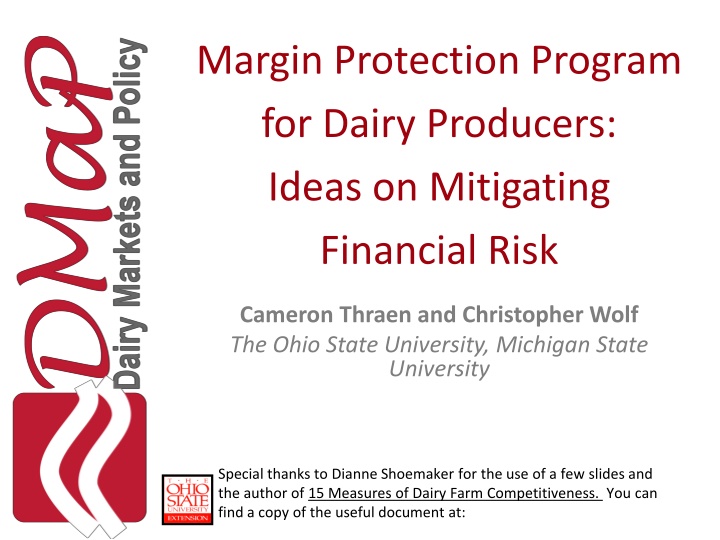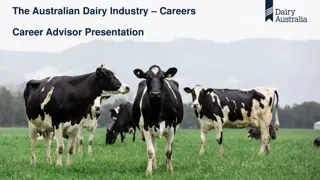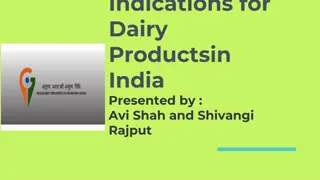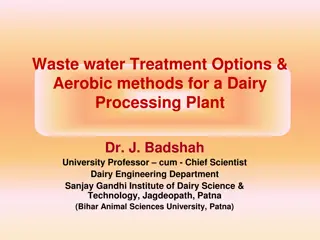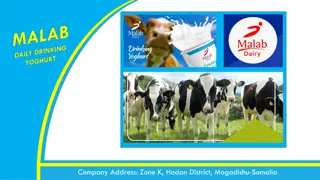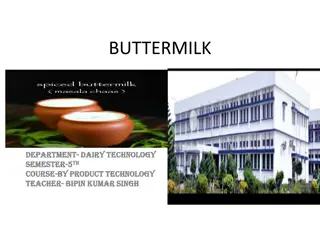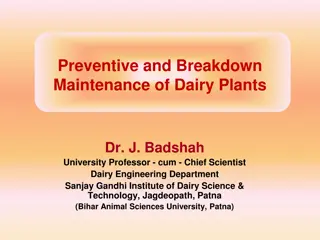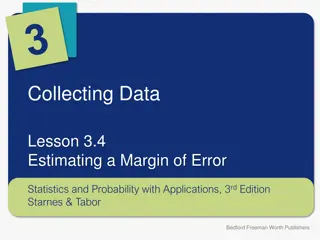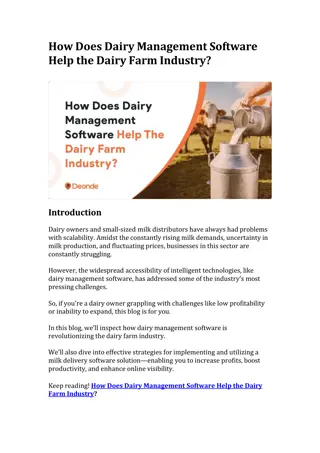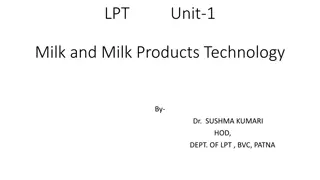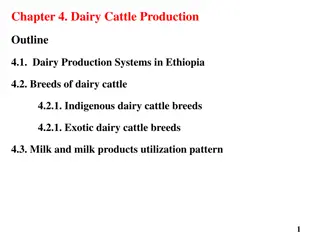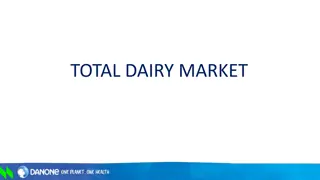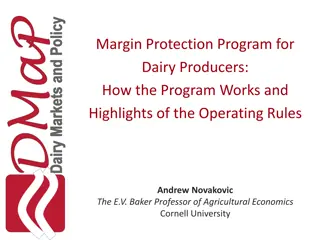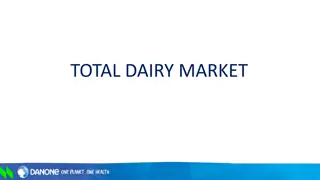Margin Protection Program for Dairy Producers: Mitigating Financial Risk
This document discusses strategies for managing financial risk in dairy farming, specifically focusing on the Margin Protection Program. The authors from Ohio State University and Michigan State University provide insights and recommendations to help dairy producers navigate challenges and improve competitiveness in the industry.
Download Presentation

Please find below an Image/Link to download the presentation.
The content on the website is provided AS IS for your information and personal use only. It may not be sold, licensed, or shared on other websites without obtaining consent from the author.If you encounter any issues during the download, it is possible that the publisher has removed the file from their server.
You are allowed to download the files provided on this website for personal or commercial use, subject to the condition that they are used lawfully. All files are the property of their respective owners.
The content on the website is provided AS IS for your information and personal use only. It may not be sold, licensed, or shared on other websites without obtaining consent from the author.
E N D
Presentation Transcript
Margin Protection Program for Dairy Producers: Ideas on Mitigating Financial Risk Cameron Thraen and Christopher Wolf The Ohio State University, Michigan State University Special thanks to Dianne Shoemaker for the use of a few slides and the author of 15 Measures of Dairy Farm Competitiveness. You can find a copy of the useful document at:
Who is the National Program on Dairy Markets and Policy A voluntary association of Land Grant agricultural economists who share an interest in the economics of dairy markets and policy and who are committed to provide educational and research materials to assist policy-makers and dairy industry decision-makers. Marin Bozic University of Minnesota Brian Gould University of Wisconsin John Newton University of Illinois Charles Nicholson The Pennsylvania State University Andrew Novakovic Cornell University Mark Stephenson Cameron Thraen Christopher Wolf University of Wisconsin The Ohio State University Michigan State University 27 August 2014 The National Program on Dairy Markets and Policy 2
What is the MPP-Dairy Producer Decision Education Project? Funded by USDA Farm Service Agency, as authorized by the Agricultural Act of 2014 For the purpose of developing a decision tool for dairy farmers and complementary educational programs Conducted under a university consortium led by the University of Illinois and referred to as the National Coalition for Producer Education. 27 August 2014 The National Program on Dairy Markets and Policy 3
Presentation Outline (How to think about my operations need for MMP) Assessing the likelihood and potential impact of adverse events Double Whammy Low milk prices & high feed prices (2009 event) Single Whammy High feed prices (2012 event) 27 August 2014 The National Program on Dairy Markets and Policy 4
Presentation Outline (How to think about my operations need for MMP) Assessing the likelihood and potential impact of adverse events Rumsfeld Whammy: The Unknown Unknowns ? Using MPP to develop contingency plans to deal with UU events ! 27 August 2014 The National Program on Dairy Markets and Policy 5
How do you know if your farm is at risk? Milking lots of cows? High rolling herd average? Big, new, 4WD truck? Bounder parked in drive? The right tractors? Big bunker silos? Robots?
Different Farms ...Different Risk ...Different Plan
Calculating Milk to Feed Margins Correlated with profit on dairy farms Milk is largest source of revenue and feed is largest expense Use historic information on milk prices and feed purchases plus homegrown feed 3-5 years information is preferred Recent years include highs (2011) and lows (2009, 2012)
Examples of dairy operations IOFC Milk cows Milk prod. Milk price Milk revenue IOFC margin Feed cost IOFC Head cwt $/cwt $ $/cwt $ $/cwt Leaders Dairy 161 37,004 20.03 741,190 517,316 223,874 6.05 Legends Dairy 324 82,766 20.23 1,674,356 1,160,379 513,977 6.21
Relationship to ADPM to Dairy Farm Record IOFC Margin (annual basis) 16 14 12 $/cwt 10 8 6 4 2 0 2000 2001 2002 2003 2004 2005 2006 2007 2008 2009 2010 2011 2012 IOFC ($/cwt) IOPFC MPP IOFC
Key Measures to monitor: Where do I Start ? Your Dairy s Financial Balance Sheet
Determining Risk Exposure from Unanticipated Low Margins Step 1: Calculate the amount of loss your operation can withstand Step 2: Evaluate the magnitude of the loss and impact on farm liquidity and solvency Balance Sheet information is required
Potential decrease in IOFC margin from 2013 level Potential reduction in IOFC from anticipated IOFC 60% Actual 2013 20% 40% 80% reduction reduction reduction reduction $ s Leaders Dairy 223,874 44,775 89,550 134,324 179,099 Legends Dairy 513,977 102,795 205,591 308,386 411,182 Those darn Unknown Unknowns The 2009 event was close to the 60% reduction for a typical dairy farm
Leaders Dairy Balance Sheet, January 1, 2014 Assets Current Total Current Assets Liabilities Current Total Current Liabilities $ $ 164,291 158,684 Noncurrent Noncurrent Liabilities 483,451 Total Noncurrent Assets 1,929,514 Total Farm Assets 2,093,805 Total Farm Liabilities 642,135 Total Farm Equity 1,451,670 Current Ratio 1.04 Debt-to-Asset Ratio 0.31
Legends Dairy Balance Sheet January 1, 2014 Assets Current Liabilities Current Total Current Liabilities $ $ Total Current Assets 548,996 260,890 Noncurrent Noncurrent Liabilities 2,456,782 51,579 Total Noncurrent Assets 4,424,483 Total Farm Assets 4,973,479 Total Farm Liabilities 2,717,672 Total Farm Equity 2,255,807 Current Ratio 2.10 Debt-to-Asset Ratio 0.55
Dairy 2013 six pack Current Ratio Working capital Current Assets Current Liabilities Debt/asset ratio Assets & Liabilities Debt per cow Debt repayment schedule Cost of production Net Farm Income per cow
Key Measures of Financial Strength Liquidity: the ability of a business to meet its cash financial obligations as they come due Measured using Current Ratio Solvency : the degree to which the liabilities of a business are backed up by assets Measured using Debt-to-Asset Ratio
Liquidity: Working Capital Calculation of working capital: Current Assets minus Current Liabilities Current Ratio 18
Liquidity: Working Capital Average WC values and % of total expenses: 2012 NY Business Summary: Small Herds <120 All herds (34) 19% Top 50% 17% $ 54,369 $ 57,685 2012 NY Business Summary: Large Herds >300 All herds (108) 22% Top 20% 30% $ 1,031,281 $ 1,512,945 2012 NY Business Summary: All Herds All herds (169) 22% Top 10% 30% $ 693,585 $ 1,376,812
Current Ratio = (Current Farm Assets) (Current Farm Liabilities) Guideline: <1 Poor --- 1 to 2 (fair) --- >2.0 (good) - Indicates the ability to liquidate current assets to cover current liabilities without impacting adversely on the farm s ongoing operations
Liquidity: Current Ratio Average CR values and % of total expenses: 2012 NY Business Summary: Small Herds <120 All herds (34) 2.05 Top 50% 1.91 2012 NY Business Summary: Large Herds >300 All herds (108) 2.52 Top 20% 3.06 2012 NY Business Summary: All Herds >300 All herds (169) 2.50 Top 10% 3.25
Solvency: Debt to Asset Ratio Measures the ability of the business to meet all debt obligations At a point in time If all assets are sold Varies over the life of the business New business Expanding business Pre-retirement business
Debt to Asset Ratio Competitive level: 40 percent
Debt to Asset Ratio An Example: Calculation: $ 850,000 debt 2,500,000 assets = 0.34 x 100_________ = 34% D/A ratio (Total farm debts total farm assets) x 100
Can your Debt to Asset ratio be too high or too low ? Too high: Why? Stage of business Too much debt Too low: Why? Rent vs. own Check Other measures Net farm income Profitability Need more investment for profit? Check Other measures Current ratio Debt repayment Profitability
Debt to Asset Ratio (D/A) = (Total Farm Liabilities) (Total Farm Assets) Guideline: higher value is considered an indicator of greater financial risk Over +0.60 (poor) Between 0.40-0.60 (fair) Under +0.40(good) - D/A tells you the share of business assets owed to creditors D/A Good Poor
Solvency: Debt/Asset Average DA values : 2012 NY Business Summary: Small Herds <120 All herds (34) +0.23 Top 50% +0.26 2012 NY Business Summary: Large Herds >300 All herds (108) +0.32 Top 20% +0.26 2012 NY Business Summary: All Herds All herds (169) +0.31 Top 10% +0.29
Debt/Asset & Cash Flow An adequate D/A ratio does not necessarily mean your business has the ability to meet cash flow obligations
How do you handle poor margins? Liquidity is used first. Cash reserves are tapped. Equity can be used to acquire operating loans. Current assets are sold Selling intermediate or long-term assets has lasting consequences for the operation.
How can MPP Protect Farm Financial Assets? The anticipation is that the MPP margin will correlate with actual farm margins. Farmers can use past farm records to assess the relevance and use of MPP margin. Set coverage level based on needs to maintain liquidity and solvency.
Identify your Financial Tolerance for Risk $8.00 Coverage Level $6.00 $4.00 60% 90% 25% Coverage Quantity
Select a combination of CL and C% that your checkbook can accommodate MPP Cost vs. Coverage Level vs. Coverage % $40,000 $35,000 $30,000 0.85 $25,000 0.75 0.65 $20,000 0.55 $15,000 0.45 $10,000 $5,000 0.35 $0 8 7.5 7 6.5 6 0.25 6m # PH 5.5 5 4.5 4 MPP cost rises dramatically above $6.50 and nearing 90% CL
How Inadequate of a Margin can your Operation Withstand? Know your farm s key financial measures. Are they at strong target levels ? CR above a target level Above 2.0 DA below some target Perhaps 0.4 or 0.6 Understand the impact that a low margin will have on these key measures of financial strength.
Conclusions Farms with larger amounts of financial risk must pay more attention to risk management. Use financial statements to assess your farm s risk position. Decide whether or not the MPP can be an important part of managing financial risk.
Margin Protection Program for Dairy Producers: Ideas on Mitigating Financial Risk Cameron Thraen and Christopher Wolf The Ohio State University, Michigan State University Special thanks to Dianne Shoemaker for the use of a few slides and the author of 15 Measures of Dairy Farm Competitiveness. You can find a copy of the useful document at:
